AMD-K6-233ANR — AMD — WikiChip
AMD-K6-233ANR was a 32-bit x86 microprocessor designed by AMD and introduced in early 1997. This chip, which was based on AMD’s new K6 microarchitecture, operated at 233 MHz and dissipated a maximum of 28.3 W.
Contents
- 1 Cache
- 2 Graphics
- 3 Features
- 4 Documents
- 4.1 DataSheet
- Main article: K6 § Cache
L2$ can be 256 KiB to 1 MiB, depending on manufacturer and motherboard model. L2$ is off-chip.
| Cache Info [Edit Values] | ||
| L1I$ | 32 KiB
0.0313 MiB |
1×32 KiB 2-way set associative |
| L1D$ | 32 KiB
0.0313 MiB |
1×32 KiB 2-way set associative |
Graphics[edit]
This SoC has no integrated graphics processing unit.
Features[edit]
[Edit/Modify Supported Features]
|
Supported x86 Extensions & Processor Features |
||
|
||
- Auto-power down state
- Stop clock state
Documents[edit]
DataSheet[edit]
- AMD-K6 MMX Enhanced Processor Multimedia Technology; Publication #20695 Revision E/0; June 1997
Facts about «AMD-K6-233ANR — AMD»
RDF feed
| base frequency | 233.33 MHz (0.233 GHz, 233,330 kHz) + |
| bus rate | 66.66 MT/s (0.0667 GT/s, 66,660 kT/s) + |
| bus speed | 66.66 MHz (0.0667 GHz, 66,660 kHz) + |
| bus type | FSB + |
| clock multiplier | 3.5 + |
| core count | 1 + |
| core family | 5 + |
| core model | 6 + |
| core name | 6k86 + |
| core voltage | 2.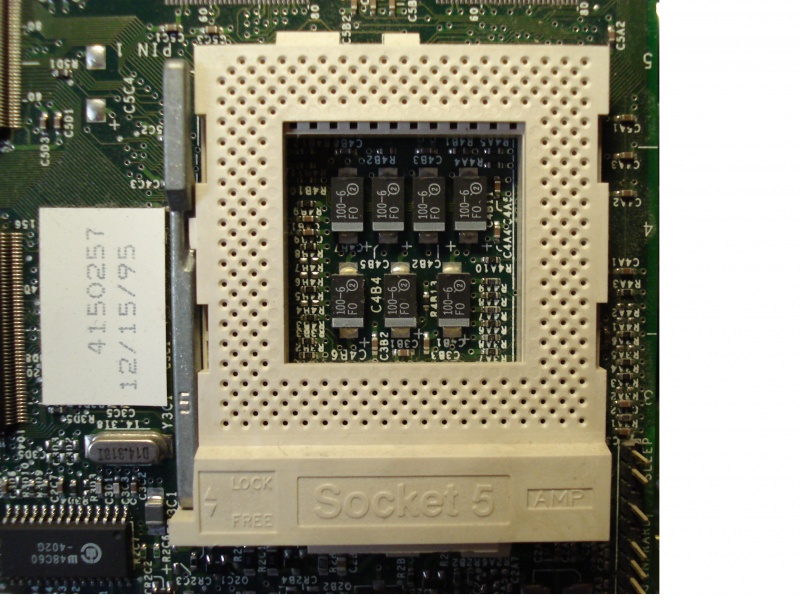 9 V (29 dV, 290 cV, 2,900 mV) + 9 V (29 dV, 290 cV, 2,900 mV) + |
| core voltage tolerance | 5% + |
| cpuid | 560 + |
| designer | AMD + |
| die area | 162 mm² (0.251 in², 1.62 cm², 162,000,000 µm²) + |
| family | K6 + |
| first announced | May 1997 + |
| first launched | May 1997 + |
| full page name | amd/k6/amd-k6-233anr + |
| has locked clock multiplier | false + |
| instance of | microprocessor + |
| io voltage | 3.3 V (33 dV, 330 cV, 3,300 mV) + |
| io voltage tolerance | 5% + |
| l1d$ description | 2-way set associative + |
| l1d$ size | 0.0313 MiB (32 KiB, 32,768 B, 3.051758e-5 GiB) + |
| l1i$ description | 2-way set associative + |
| l1i$ size | 0.0313 MiB (32 KiB, 32,768 B, 3.051758e-5 GiB) + |
| ldate | May 1997 + |
| main image | + |
| main image caption | 233ANR, Week 46, 1997 + |
| manufacturer | AMD + |
| market segment | Desktop + |
| max case temperature | 343. 15 K (70 °C, 158 °F, 617.67 °R) + 15 K (70 °C, 158 °F, 617.67 °R) + |
| max cpu count | 1 + |
| max memory | 4,096 MiB (4,194,304 KiB, 4,294,967,296 B, 4 GiB, 0.00391 TiB) + |
| max storage temperature | 423.15 K (150 °C, 302 °F, 761.67 °R) + |
| microarchitecture | K6 + |
| min case temperature | 273.15 K (0 °C, 32 °F, 491.67 °R) + |
| min storage temperature | 208.15 K (-65 °C, -85 °F, 374.67 °R) + |
| model number | AMD-K6-233ANR + |
| name | AMD-K6-233ANR + |
| part number | AMD-K6-233ANR + |
| power dissipation | 28.3 W (28,300 mW, 0.038 hp, 0.0283 kW) + |
| process | 350 nm (0.35 μm, 3.5e-4 mm) + |
| series | Desktop K6 + |
| smp max ways | 1 + |
| technology | CMOS + |
| thread count | 1 + |
| transistor count | 8,800,000 + |
| word size | 32 bit (4 octets, 8 nibbles) + |
AMD Mobile K6 233 MHz
We specialized in CPU trade, contact us if you need bulk sale or purchase this kind of CPU,please do not hesitate to contact us :
Email :raymond@nbcpu.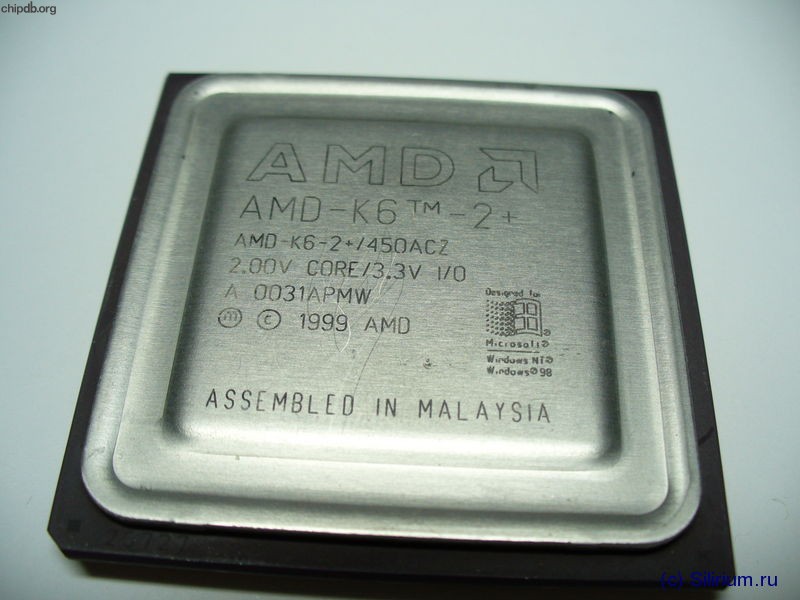 com,Tel: +86 0755-82928539
com,Tel: +86 0755-82928539
| Type:CPU | Manufacturer:AMD |
| family:Mobile K6 | microprocessors:AMD Mobile K6 233 MHz — AMD-K6/233ADZ |
| Type | CPU / Microprocessor |
| Market segment | Mobile |
| Family |
AMD K6 |
| CPU part number |
|
| Frequency | 233 MHz |
| Package | 321-pin ceramic staggered PGA 1.95″ x 1.95″ (4.95 cm x 4.95 cm) |
| AMD Package numbers | 25898, 26031 |
| Socket | Socket 7 |
| Architecture / Microarchitecture | |
| Microarchitecture | K6 |
| CPUID | 570 |
| Manufacturing process | 0. 25 micron 25 micron |
| Data width | 32 bit |
| Floating Point Unit | Integrated |
| Level 1 cache size | 32 KB code with pre-decode cache 32 KB writeback data |
| Features | MMX instructions |
| Low power features |
|
| Electrical / Thermal parameters | |
| V core | 2.1V |
| Min/Recommended/Max V I/O or secondary | 3.135V / 3.3V / 3.6V |
AMD Mobile K6 233 MHz — AMD-K6/233ADZmicroprocessors pictures
other microprocessors
|
AMD Mobile K6 233 MHz — AMD-K6/233BCZ |
AMD Mobile K6 266 MHz — AMD-K6/266ACZ |
|
AMD Mobile K6 266 MHz — AMD-K6/266ADZ |
AMD Mobile K6 266 MHz — AMD-K6/266BCZ |
|
AMD Mobile K6 300 MHz — AMD-K6/300ADZ |
AMD Mobile K6 300 MHz — AMD-K6/300BDZ |
|
AMD Mobile K6-2 266 MHz — AMD-K6-2/266ANZ |
AMD Mobile K6-2 266 MHz — AMD-K6-2/266BNZ |
|
AMD Mobile K6-2 300 MHz — AMD-K6-2/300ANZ |
AMD Mobile K6-2 300 MHz — AMD-K6-2/300ANZ-66 |
|
AMD Mobile K6-2 300 MHz — AMD-K6-2/300BNZ |
AMD Mobile K6-2 333 MHz — AMD-K6-2/333ANZ |
Tel:+86 0755-83247530 Email:raymond@nbcpu. com
com
NBCPU All rights reserved..
Retroclocking: overclocking AMD K6
Table of contents
- Introduction
- A bit of history
- Test stand
- Test results
- Super Pi mod. 1.5XS (task 1M)
- PiFast v.4.1
- wPrime v.1.43
- HWBOT Prime v.0.8.3
- 3DMark 2000 Pro v.1.1
- 3DMark 2001 SE Pro b330
- AIDA64 5.50.3600
- Extreme overclocking of the fastest AMD K6
- Compare results
- Super Pi mod. 1.5XS (task 1M)
- PiFast v.4.1
- wPrime v.1.43
- AIDA64 5.50.3600
- 3DMark 2000 Pro v.1.1
- 3DMark 2001 SE Pro b330
- Quake III Arena v.1.32
- Conclusion
Introduction
We continue the series of articles on retroclocking. Looking ahead, I will say that the topic of Socket 7 cannot let me go, too many different interesting processors for this socket have been released. Representatives of Intel Pentium MMX have already visited the laboratory, the time has come for their competitors.
Representatives of Intel Pentium MMX have already visited the laboratory, the time has come for their competitors.
This time we’re talking about the AMD K6 family of CPUs. I had enough processors marked AMD, and I decided to take the entire line — from the very first AMD K6 without an index to AMD K6-III, in order to compare them under the same conditions. And as a bonus, you will find extreme overclocking of the fastest AMD K6-III using a phase transition system (“freons”).
Before continuing, let’s recall my materials on Intel Pentium MMX:
- Retroclocking: studying the overclocking potential of seven Pentium MMX processors;
- Retroclocking: overclocking Pentium MMX on Tillamook (Socket 7) core.
recommendations
A bit of history
AMD K6 family processors can be called successful in every sense, which cannot be said about their predecessors, AMD fifth generation CPUs. But AMD’s K6 success came thanks to the company’s failure with the K5 family.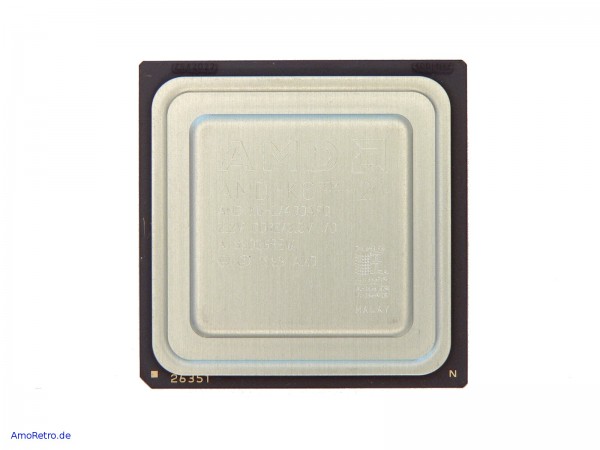
In search of a fix for a deplorable situation, AMD buys NexGen (for $600 million), which made fifth-generation processors with x86 instructions executed by an internal RISC core. NexGen had enough developments, but a separate platform and incomplete compatibility of their solutions, both software and hardware, with the generally accepted standard of those times in the form of Socket 5, put the entire business at risk, which AMD took advantage of.
The result of this transaction was not long in coming, and the first result of the combined efforts of AMD and NexGen was the AMD K6 processor, which took the best practices of NexGen engineers.
So, the first AMD K6 (Model 6) processor with a frequency of 166 MHz was announced on April 2, 1997. AMD abandoned the PR-rating used in previous solutions of the K5 generation, now AMD K6 CPUs were marked with a real frequency, and Intel Pentium II with a similar frequency was positioned as a competitor.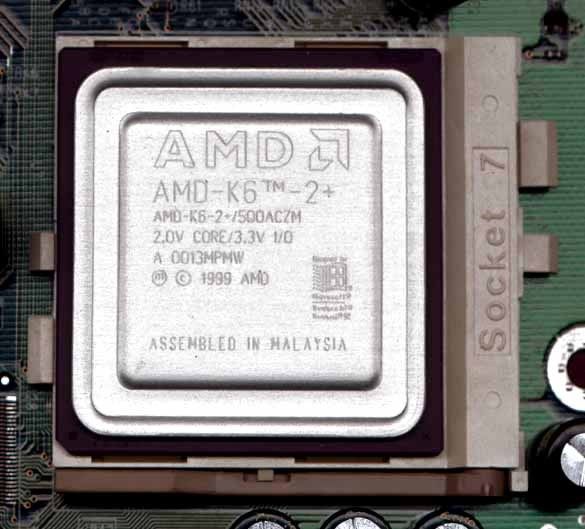
AMD K6 (Model 6) processors were produced according to the 350 nm process technology, contained 8.8 million transistors, supported MMX instructions and, unlike the competitor, included a large L1 cache: 32 KB for data and 32 KB for instructions. Pentium II (as well as Pentium MMX) was content with only half of this amount: 16 KB for data and 16 KB for instructions. The weak point of the AMD K6 was the FPU, but despite this, the processor was available to the general public due to its affordable price. The AMD K6 (Model 6) lineup consisted of a line of models with a frequency of 166 to 233 MHz. The older model with 233 MHz cost $170 less than the Pentium II with the same frequency. The beginning of the success of AMD K6 processors was laid.
A year later, on April 7, 1998, AMD decides to make (as it is now fashionable to call it) a «Refresh» of the K6 (Model 6) line, transferring it to a thinner process technology — 250 nm. The updated line of AMD K6 processors was called «Little Foot» (Model 7). In fact, we still have the same K6 (Model 6) processor, but manufactured using a more subtle technical process, due to which the CPU operating voltage has decreased, the die area has decreased by more than half, and, most importantly, clock frequencies have grown. The top «Little Foot» (Model 7) is a 300 MHz CPU. Its cost was set at $246. Around the same time (April 15, 1998) was already available Pentium II with a frequency of 350 MHz and FSB 100 MHz, but its cost was two and a half times higher and amounted to $621.
In fact, we still have the same K6 (Model 6) processor, but manufactured using a more subtle technical process, due to which the CPU operating voltage has decreased, the die area has decreased by more than half, and, most importantly, clock frequencies have grown. The top «Little Foot» (Model 7) is a 300 MHz CPU. Its cost was set at $246. Around the same time (April 15, 1998) was already available Pentium II with a frequency of 350 MHz and FSB 100 MHz, but its cost was two and a half times higher and amounted to $621.
The AMD K6-2 subfamily became the next round of progress in the AMD K6 processor family. The new processors were designed to compete with the most advanced Pentium II on the «Deschutes» core, which acquired a FSB of 100 MHz and frequencies up to 450 MHz. The announcement of AMD K6-2 processors on the «Chomper» core took place on May 28, 1998. The lineup consisted of CPUs with a frequency of 233 to 350 MHz. The number of transistors has grown slightly — from 8.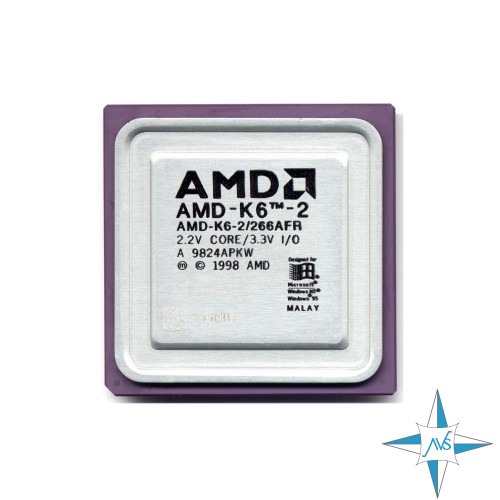 8 million to 9.3 million, but support for 100 MHz FSB appeared, the manufacturing process did not change, but new instructions were added, called 3DNow!, whose task was to accelerate 3D graphics.
8 million to 9.3 million, but support for 100 MHz FSB appeared, the manufacturing process did not change, but new instructions were added, called 3DNow!, whose task was to accelerate 3D graphics.
And it should be noted that the new instructions were positively received by the gaming industry, every second game manufacturer declared support for their games with these instructions. Even Microsoft, with the release of API DirectX 6.0, brought support for new AMD instructions, video card driver manufacturers also started optimizing their software for them. In practice, of course, it was not so smooth, somewhere the support was half-fulfilled, but on the whole everything turned out well.
In November 1998, the line was updated, the new K6-2 processors received an improved core — Chomper Extended (CXT). The improvement, it should be noted, was small, the CPU learned to work with RAM a little faster thanks to the Write-Combining technology, but otherwise we had the same CPU with the same technical process and similar characteristics.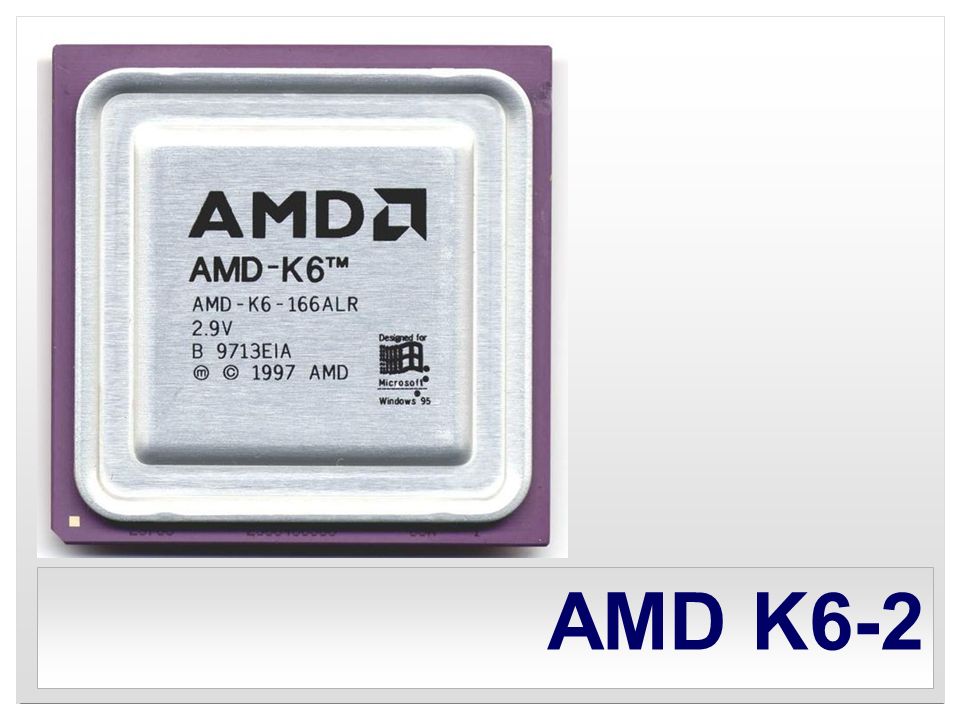 The new core gave rise to new models, the frequency range of which has grown up to 550 MHz. Often the assembly of a system unit based on AMD K6-2 was twice as economical as on a competing Intel platform. The existence of K6-2 can be called the «golden age» for AMD.
The new core gave rise to new models, the frequency range of which has grown up to 550 MHz. Often the assembly of a system unit based on AMD K6-2 was twice as economical as on a competing Intel platform. The existence of K6-2 can be called the «golden age» for AMD.
In the comparison that we will make below, the AMD K6-2 model participates, but with an additional «+» (plus index) — K6-2+. Although on paper this is the second generation of K6, albeit with a plus, but in terms of characteristics, this CPU is very different from its “no plus” counterparts. If you do not take into account that AMD, one might say, was late with the release of this CPU to the market, the processor turned out to be just as good as its predecessor.
It was produced using an even thinner 180 nm process technology, supported by energy-saving PowerNow! (similar to Intel SpeedStep), thanks to which it became possible to change the multiplier on the fly. But most importantly, 128 KB of second-level cache was added, running at the frequency of the CPU core, which was located on the processor chip. Prior to AMD K6-2+, no AMD K6 had its own L2 cache. Thanks to the cache located on the motherboard, which was represented in the system as L3, a good performance boost could be obtained. AMD K6-2+ clock speeds started at 450 MHz and ended at 570 MHz.
Prior to AMD K6-2+, no AMD K6 had its own L2 cache. Thanks to the cache located on the motherboard, which was represented in the system as L3, a good performance boost could be obtained. AMD K6-2+ clock speeds started at 450 MHz and ended at 570 MHz.
Everything would be fine, but the CPU data was intended by the company exclusively for the mobile sector of the market (in other words, AMD K6-2+ was used mainly in laptops). Despite this, the processor was physically compatible with Socket 7 and most modern motherboards of that time worked without any problems, it was only necessary to update the BIOS firmware.
In February 1999, the third version saw the light — AMD K6-III, codenamed «Sharptooth». The processor was manufactured according to the 250 nm process technology, consisted of 21.4 million transistors, supported 100 MHz FSB, and was essentially the same K6-2 on the Chomper Extended (CXT) core, with support for packet memory technology, but with twice as much as AMD K6-2+, L2 cache. The volume of L2 in AMD K6-III was 256 KB, it worked at the frequency of the CPU core. The frequencies of new products started at 333 MHz and ended at 450 MHz.
The volume of L2 in AMD K6-III was 256 KB, it worked at the frequency of the CPU core. The frequencies of new products started at 333 MHz and ended at 450 MHz.
On April 18, 2000, plus brothers AMD K6-III were born. Their purpose was similar to K6-2+, the process of their production is similar — 180 nm, in fact it was K6-2+, but with an L2 cache increased to 256 KB.
The evolution of the K6 family of processors is perfectly demonstrated by AMD’s archive slide.
Subscribe to our channel in Yandex.Zen or telegram channel @overclockers_news — these are convenient ways to follow new materials on the site. With pictures, extended descriptions and no ads.
AMD-K6 MMX — a profitable alternative today
AMD-K6 MMX — a profitable alternative today
The arrival of a new CPU always causes a revolution in technology development. Apps and operating systems are emerging that use the full power of the new engine. In turn, the requirements for high CPU performance and new software reveal the bottlenecks of the computer system as a whole and lead to the emergence of hardware solutions.
In turn, the requirements for high CPU performance and new software reveal the bottlenecks of the computer system as a whole and lead to the emergence of hardware solutions.
The beginning of 1997 was full of announcements of new processors. The buzz around Intel’s Pentium MMX has not subsided yet, as AMD (Advanced Micro Devices, Inc.) announced the start of sales of the AMD-K6 MMX series processors, covering, according to its statements, both the Pentium Pro and the new Pentium MMX. Apparently, AMD managed to catch up technologically with its formidable competitor. At least as far as the high end personal computer CPU market is concerned. In the class of mid-level and especially entry-level systems (AMD-K5), companies have been competing for a long time.
On the one hand, the cost of solutions from AMD has always attracted (especially our compatriots). On the other hand, Intel waved the flag of the leader, frightening meticulous users with rumors that its processors are the fastest and will certainly be compatible with all the next versions of Windows XX and beyond. A trick was used when the leader (and a monopolist rolled into one) for his new processors himself began to produce chipsets and even motherboards. But independent manufacturers of motherboards and chipsets, pursuing by no means political interests, continued and continue to produce products compatible with AMD and Cyrix (even on chipsets from Intel).
A trick was used when the leader (and a monopolist rolled into one) for his new processors himself began to produce chipsets and even motherboards. But independent manufacturers of motherboards and chipsets, pursuing by no means political interests, continued and continue to produce products compatible with AMD and Cyrix (even on chipsets from Intel).
The good news is that as a result, prices for high-end systems are dropping faster every year. (Maybe that’s why, when releasing new products, manufacturers raise their prices so high — so that there is room to fall.) And although the thunder of fanfare after the announcement of the AMD-K6 MMX microprocessor has not yet completely subsided, you can already look at it quite calmly and without advertising hype.
What was that?
So, on April 2, 1997, an event occurred that certainly aroused the interest of many users of personal computers on the PC platform. On this day, the sixth generation x86 processor was announced and went on sale, but not from Intel, but from AMD. A new series of CPUs has appeared under the trademark AMD-K6 MMX.
A new series of CPUs has appeared under the trademark AMD-K6 MMX.
According to AMD and reports from independent experts, this processor belongs to the sixth generation not for marketing reasons, but precisely because of its performance and architecture. It can be said that for the first time in the computer industry, the gap between the best Intel processors and compatible processors from other manufacturers has narrowed so much. (According to some parameters, there is still a question — who is ahead of whom.)
AMD has once again confirmed that it really has a very strong team of developers of modern processors. Thanks to original AMD solutions, it was possible to develop and release a processor that is as different in its internal structure from the Pentium Pro as it is compatible with Pentium and Pentium MMX motherboards. And at the same time, it is a real alternative to the Pentium Pro, and in some respects even more attractive to a large number of users. Among «some» in the first place, of course, is the price of the CPU, on which the cost of the entire computer directly depends. And by «majority» we mean adherents of inexpensive solutions, of which there are a great many not only here, but all over the world.
And by «majority» we mean adherents of inexpensive solutions, of which there are a great many not only here, but all over the world.
The AMD-K6 MMX is currently the fastest available x86 processor for computing under the Windows 95 operating system. And although the test results under DOS and Windows NT are not so impressive ( see www.personal.v-net.com/~sysdoc/k6.html for details), yet the K6 is by far the fastest alternative available for the average PC user today.
If the motherboard allows, if desired, the K6-233 processor can be overclocked (this is called overclocking) to 250/83 or 262.5/75 MHz (CPU speed / bus speed). Interestingly, even in such a super-hard mode, the new processor, according to eyewitnesses, works stably.
Figure 1. Windows 95 benchmark results Source: Tom’s Hardware Guide
Details — with frequencies of 166, 200 and 233 MHz. Unlike the practice of competitors, K6 can be installed in those boards that are already being produced today. The processor contains 8.8 million transistors and is manufactured in a Socket 7 compatible 321-pin ceramic CPGA (Ceramic Pin Grid Array) package at the Fab 25 factory in Austin, USA. Texas. All processors of the K6 family work with the external bus frequency of 66 MHz, which has long become standard in modern motherboards.
The processor contains 8.8 million transistors and is manufactured in a Socket 7 compatible 321-pin ceramic CPGA (Ceramic Pin Grid Array) package at the Fab 25 factory in Austin, USA. Texas. All processors of the K6 family work with the external bus frequency of 66 MHz, which has long become standard in modern motherboards.
From a purely technical point of view, it is respectable that AMD has managed to achieve high performance of its new processors while using a small amount of internal L1 cache. It is known that the Pentium Pro achieves high performance, including by increasing the size of the internal cache (256/512/1.024 KB). And AMD-K6 MMX processors have a meager amount of L1 cache memory by today’s standards — 64 KB.
One of the most important features is that the new processor is pin-compatible with Socket 7. Thus, by installing the K6 in a Pentium board, consumers get a Pentium Pro-class system. It’s no secret that Intel’s Pentium Pro processor requires the use of special motherboards, and, as a rule, from more than serious manufacturers (which is far from helping to reduce the cost of the system).
When using K-6, you can get by with motherboards released even six months ago on HX, TX (Intel) chipsets, VIA 2 chipsets, SIS 5571, OPTI … This, in turn, gives many manufacturers of motherboards a real chance (and not just Intel) quickly master the production of high-end products.
AMD-K6 MMX works even when the BIOS doesn’t recognize it correctly. True, in some cases, some of the functions are lost, but only a part. However, given the prevalence of Flash BIOS technology, this is not a serious problem today. By the way, such major motherboard manufacturers as FIC, Giga-Byte, Tyan, A-Open and ASUSTeK have already announced support for K6. On the WWW pages of these companies, you can find information not only about new models that take full advantage of the K6, but also about how to set up already released boards for installing a new processor. BIOS vendors American Megatrends, Award Software and Phoenix also plan to provide more comprehensive support for K6 in new versions of their products in the very near future.
The AMD-K6 processor is designed as a high performance solution not only for 32-bit but also for 16-bit applications. It is this fact that allows us to position it as the optimal performance solution for Windows platforms. Without the reservations that take place in the case of the Pentium Pro, which, as you know, is not very good at working with «old» 16-bit programs and with its whole appearance hints to the user that they need to spend money on new 32-bit software. As for the multimedia that has been popular lately (especially after January 8), all K6 processors, in addition to working out traditional x86 commands, support an additional set of 57 MMX commands.
Figure 2. Schematic diagram of the K6 processors. Source: BYTE magazine
According to AMD, the K6 chip has been tested for compatibility with more than 60,000 software packages for Windows 95, Windows NT, Windows 3.x, MS-DOS, Novell NetWare, OS/2 Warp, Unix operating systems , Solaris and Vines.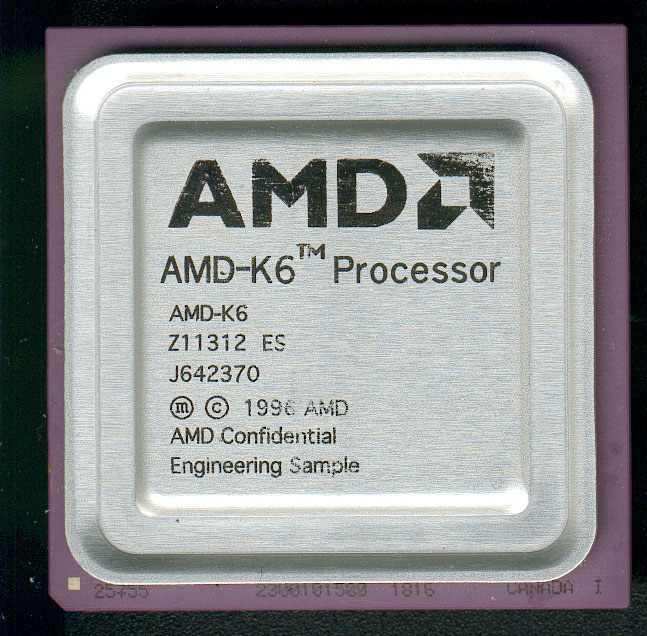 Its additional 57 MMX instructions have been tested on recent products that take advantage of this processor architecture. Considering that all comparison tests of AMD-K6 MMX processors were carried out using standard components and software (often from Intel), the reliability and compatibility of the «beginner» should not be in doubt.
Its additional 57 MMX instructions have been tested on recent products that take advantage of this processor architecture. Considering that all comparison tests of AMD-K6 MMX processors were carried out using standard components and software (often from Intel), the reliability and compatibility of the «beginner» should not be in doubt.
A bit of history
Two years ago, few noticed that a small American company, NexGen, was trying to develop a Pentium-compatible processor, but based on completely different approaches. An attempt was made to create a chip compatible with the x86 instruction set, but with a core operating as a RISC processor. At the same time, the bottleneck was the rapid decoding of x86 processor instructions and their conversion into a system of instructions for a high-performance RISC processor. Due to this combination, the developers tried to create their own original processor without using technologies licensed from Intel.
The attempt was successful, but the created processor was pin-incompatible with the standard ZIF connector that already existed at that time.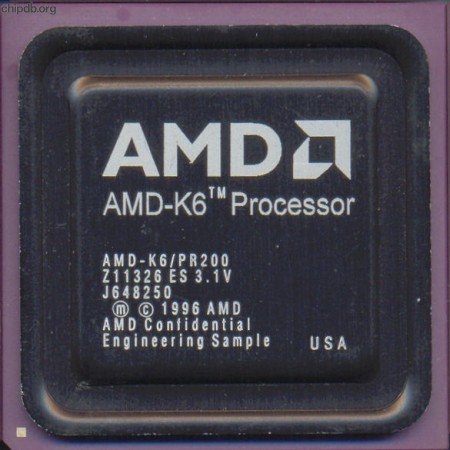 Lacking sufficient financial potential, the company failed to enter the mass market with its product. At that time, Intel did not consider this development a serious threat to the future of its CPUs. AMD management, seeing the potential of this technology, acquired NexGen. This was done, as is now obvious, to speed up the creation of the sixth generation processor, since AMD simultaneously developed the K5 and K6 processors.
Lacking sufficient financial potential, the company failed to enter the mass market with its product. At that time, Intel did not consider this development a serious threat to the future of its CPUs. AMD management, seeing the potential of this technology, acquired NexGen. This was done, as is now obvious, to speed up the creation of the sixth generation processor, since AMD simultaneously developed the K5 and K6 processors.
Not everything went smoothly with K6 at the start. Obviously, the release of the processor only in April 1997 led to the loss of a significant market share due to the activity of Intel and Cyrix. But given the performance benefits and price ratio, we can expect millions of AMD-K6 MMX chips to be sold this year.
AMD’s rosy market predictions for its new products are based on the fact that over 80% of the 75 million x86 desktop PCs use a socket and infrastructure (motherboard, chipset, BIOS) focused on ZIF Socket 7. The strong side, given the leadership of Intel, is that thanks to the efforts of AMD, K6 is compatible with the most common competitor chipsets — HX, TX.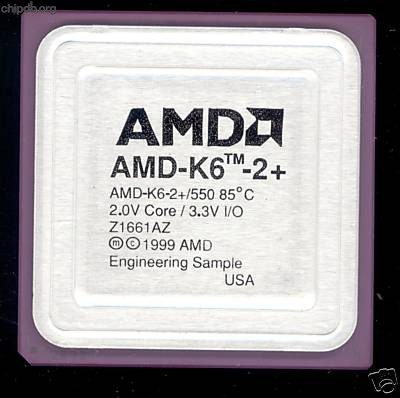
In addition, many well-known companies, including Acer Labs, ITE, National Semiconductor, OPTi, SiS, and VIA, are planning to release specialized chipsets targeting the AMD-K6 MMX series processors under AMD’s FusionPCsm program.
Further, one of AMD’s main trumps in the fight against Intel for a piece of the market pie is the pricing policy.
So, for an AMD-K6-200 processor when buying a batch of more than 1000 pcs. the manufacturer set the price at $349. Pentium Pro with a similar clock speed costs more than $500. The difference for 166 MHz K6 and Pentium Pro processors is not that big ($244 and $350 respectively), but still significant. The fastest x86 AMD-K6-233 MMX processor available in the sky at a price of $469 has no analogues for comparison yet.
From a user’s point of view, the price of a processor greatly affects the price of the entire system. Obviously, ready-made systems based on AMD CPUs will be not only more productive in the foreseeable future, but also significantly cheaper.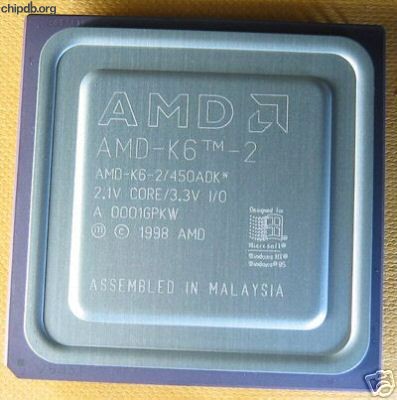
How to Install the K6
Designed with consumer demand and high competition in mind, the AMD-K6 saves money on motherboards by giving new life to motherboards bought today without requiring significant custom development.
AMD-K6 CPU Motherboard must have at least ZIF Socket 7 and support 2.9V 145mV CPU power. The motherboard power regulator must withstand current up to 7.5 A. Compatible with K6 BIOS must be dated: for Award — from March 1, 1997 or later, AMI version 3.31 or later, Phoenix version 4.0 Release 6.0 or Release 5.1 dated 04/07/97 or later.
To install the AMD-K6-233, the motherboard must support a processor power supply of 3.2 V 100 mV, and the voltage regulator can withstand a current of 9.5 A. AMD plans to release the next versions of its processors using 0.25-micron technology and, accordingly, the power requirements for the voltage regulator will be reduced.
Since the standard data bus frequency for these processors is 66 MHz, in order to correctly install a processor with an internal frequency of 166/200/233 MHz, it is necessary to match the processor and bus frequencies using jumpers on the board. In practice, for K6-166 and K6-200 this is done in the same way as for processors from Intel, however, the K6-233 processor can only be installed on boards that support matching the internal frequency of the processor and bus, a multiple of 3.5, or on boards that support bus frequencies 75 or 83 MHz.
In practice, for K6-166 and K6-200 this is done in the same way as for processors from Intel, however, the K6-233 processor can only be installed on boards that support matching the internal frequency of the processor and bus, a multiple of 3.5, or on boards that support bus frequencies 75 or 83 MHz.
According to one of the experts (Tom Pabst, Tom’s Hardware Guide), who tested the K6 for more than 9 days for performance and compatibility, motherboards such as Abit IT5H, AOpen AX5T-1, AOpen AP5T-2, Asus P / I-P55T2P4 rev. 3+, Asus TX97, FIC PA-2011, Tyan S1570, when using AMD-K6, you can achieve excellent performance. Moreover, for Windows 95 the best results are achieved on the Tyan S1570 TitanTurbo board, and for Windows NT it is better to use the FIC PA-2011 board with the VIA Apollo VP2 chipset (VT82C590), as well as with the «native» AMD 640.
On the Internet http://www.amd.com you can find a wider list of motherboards tested for compatibility with K6 processors directly by AMD.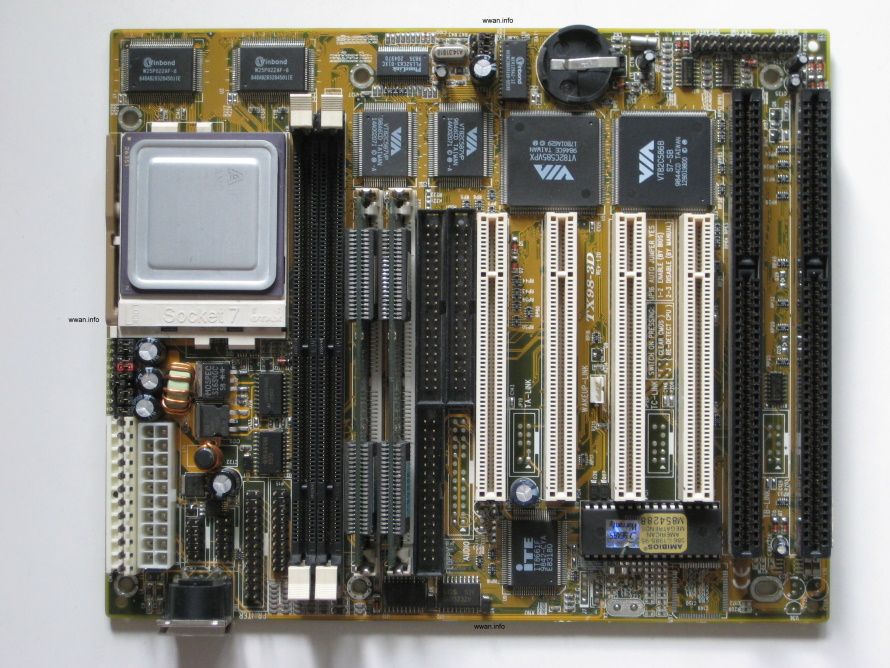 For their part, reputable motherboard manufacturers publish on their WWW pages lists of models released by them earlier and new motherboards compatible with K6. You can also find instructions for installing them and updating the BIOS to identify these processors, as well as the latest BIOS versions.
For their part, reputable motherboard manufacturers publish on their WWW pages lists of models released by them earlier and new motherboards compatible with K6. You can also find instructions for installing them and updating the BIOS to identify these processors, as well as the latest BIOS versions.
Is everything okay?
We can’t say that the K6 is completely devoid of shortcomings, although most of them can be called rather differences from the characteristics of Intel Pentium Pro class processors.
So, K6 does not provide for the possibility of building multiprocessor systems, which is relevant for modern departmental and enterprise-scale servers and powerful graphic stations used in scientific research. The AMD-K6 line is aimed at use in personal and network computers and entry-level servers.
On tasks that intensively use floating point operations (3D modeling systems, scientific calculations), according to the test results, K6 loses Pentium Pro.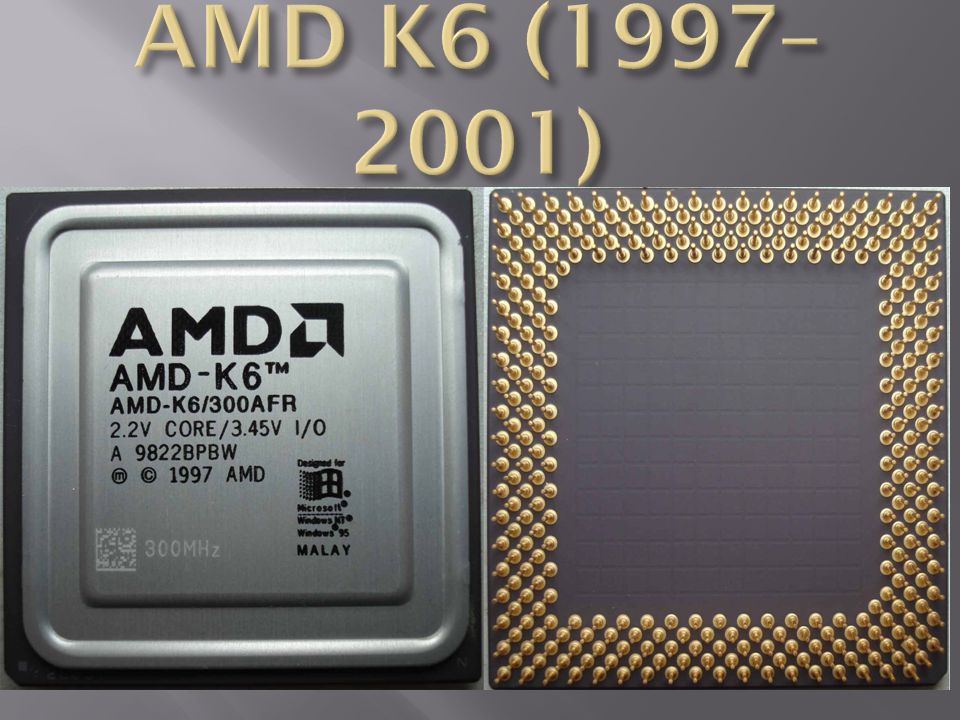 Given, however, that with the spread of MMX technology, an increasing number of applications will be reoriented to the use of integer mathematics, most users can still count on inexpensive high performance. By installing the AMD-K6-200, the end user in any case gets performance that is significantly higher than what he can get from Intel by paying the same money.
Given, however, that with the spread of MMX technology, an increasing number of applications will be reoriented to the use of integer mathematics, most users can still count on inexpensive high performance. By installing the AMD-K6-200, the end user in any case gets performance that is significantly higher than what he can get from Intel by paying the same money.
Perhaps if AMD manages to use 256 KB (or 512 KB) of internal L1 cache for the K6 and develop this processor to be compatible with the Pentium Pro, then, according to independent testers and laboratories, even future versions of the Pentium II with increased clock speeds may lose K6 (by the way, AMD plans to release K6-300 in the near future) in efficiency.
If today you have a personal computer with a Pentium-166 on your desk, then upgrading it with AMD-K6 will be quite a profitable investment. After all, then you do not have to change the motherboard and the entire environment, and replacing one processor in any case will cost half as much as replacing both the motherboard and the processor at the same time.
